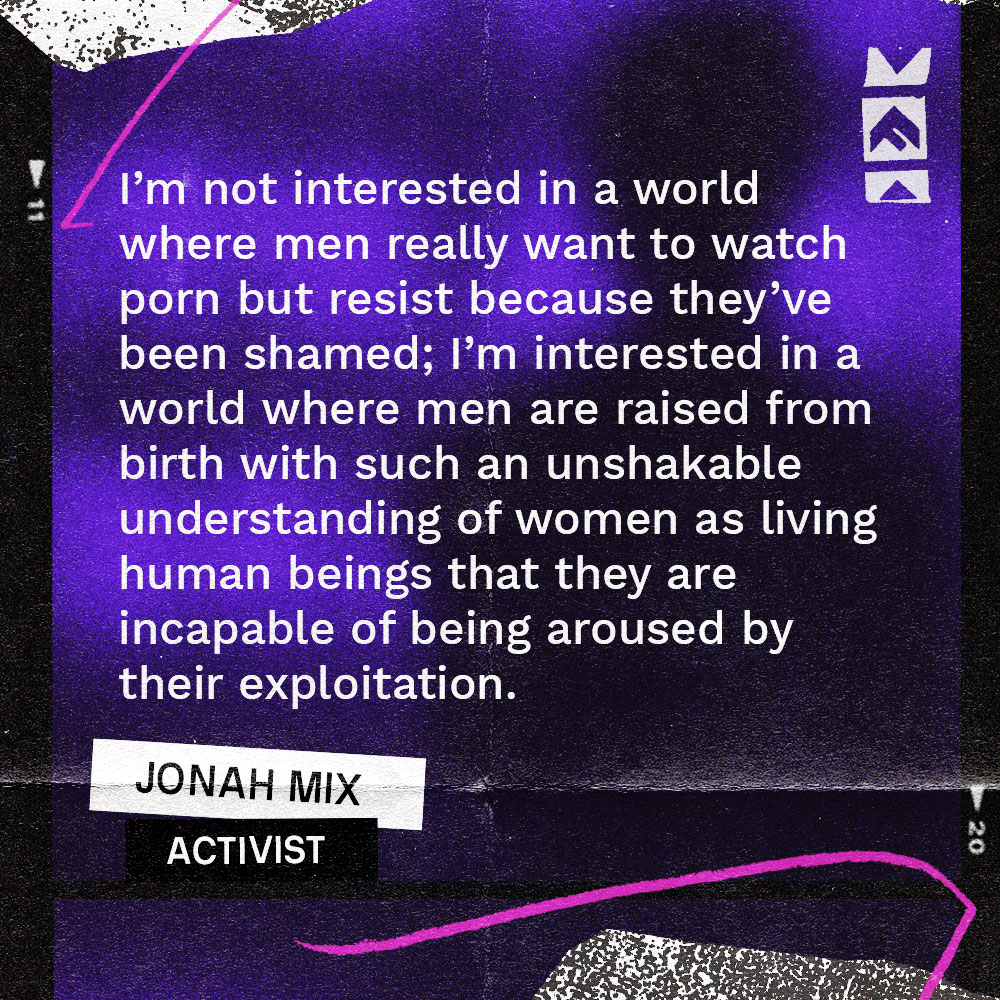Every human is hard-wired to desire real love and connection, whether that’s in a romantic relationship, through friendship, or with family.
Human beings need each other. We need empathy and understanding. And that’s a proven fact.
Recently, an article from The New York Times showed research that social isolation can cause people to die sooner and lose their cognitive abilities. It can cause problems like higher amounts of stress, lessen the amount of healthy sleep, and even increase in things like heart disease and obesity.
Human connection is key to living healthy, happy lives. And empathy, the ability to understand and share someone else’s feelings in life, is the key to deep human connection.
Empathy and objectification are incompatible
Brene Brown writes that “empathy is feeling with people.” It’s getting on someone’s level and connecting with something within yourself so you can connect with someone else. This is something that is completely lacking in porn. And, in fact, porn can diminish a consumer’s ability to empathize and the ability to love deeply.
Sam Carr, a lecturer in education and psychology at the University of Bath, recently wrote for The Conversation on how pornography wrecks our ability to empathize, fostering harassment and abuse.
Carr explains that, in a society that is trying to figure out the next steps to make the world a better place after the #MeToo movement and the scandals with Weinstein and Cosby and so many other harassers and abusers, maybe we should challenge the status quo and look into what is fueling toxic ideas in society.
Related: Can You Tell The Difference Between #MeToo Stories And Porn Plot Lines?
Can we really create a safe space where people are respected and harassment can easily be reported when sexual objectification is still a pretty significant part of our culture? After all, psychologists have found that porn negatively affects the way consumers see other people.
Carr’s point is pretty simple. Objects don’t have feelings. Objects are owned by people. If we turn people into objects, we no longer see them as having feelings and can’t empathize with them. But objectifying doesn’t just make people into objects; it also suggests ownership.
“In short, empathy and sexual objectification are incompatible,” wrote Carr. “Under a sexually objectifying gaze, women’s bodies momentarily become the ‘property’ of the observer—whether they have consented or not.”
Concerning porn scripts
A recent report discussed the different “scripts” of pornography and how they can affect the partner of a porn consumer. A “script” is basically a pattern of behavior someone defaults to follow in a certain setting, like being quiet in a public library or being loud at a football game.
This report found that the scripts of pornography lead to a few concerning things. One is that they reinforced traditional, unrealistic beauty standards rather than embracing natural beauty and body positivity. Porn behaviors also teach incorrect ideas about sex: that everyone always wants sex, that people are sexually insatiable, and that constant sexual novelty outside of a steady romantic relationship is the ideal.
Within porn, there is a lot of mechanical sex and not a lot of love, affection, and empathy. There isn’t much intimacy displayed, like cuddling, kissing or hand-holding. In fact, today’s porn is all about creating fake intimacy without the needed emotional connection that can come with real-life sexual intimacy. But the problem is, porn is a powerful teacher. Love and empathy are not featured parts of porn, and since porn is often the go-to for our generation to learn about sex and relationships, seeing that lack of demonstrated empathy over and over can fuel unhealthy ways of thinking and affect consumers’ relationships with their partners.
Related: Is There A Connection Between Porn Culture And Rape Culture?
The same researcher did a series of analyses of the 50 bestselling adult films and found that most of them lacked any empathetic concern for women and a lot of objectification. Almost half of the scenes in the films involved verbal aggression, over 88% of them involved physical aggression.
But more than that, pay attention to this part: most of the violence was done by men against women and the female performers responded with pleasure or neutrality—but it’s not just about women. Male abuse porn, available on any mainstream porn site, also shows that violence and objectification. Clearly, this is everyone’s issue.
Pointing out the problem
Porn is popular and mainstream, but it’s also full of lies and toxic ideas. So is it any wonder that these attitudes of aggression, objectification, and lack of empathy are very much a problem in our porn-obsessed society?
Partners deserve love and empathy. Everyone deserves love and empathy. Healthy relationships thrive when empathy is part of the picture. If you’re invested in sharing real love with a partner, consider ditching the porn and stick to reality. Watching just isn’t worth risking emotional numbness and lack of empathy.

Your Support Matters Now More Than Ever
Most kids today are exposed to porn by the age of 12. By the time they’re teenagers, 75% of boys and 70% of girls have already viewed itRobb, M.B., & Mann, S. (2023). Teens and pornography. San Francisco, CA: Common Sense.Copy —often before they’ve had a single healthy conversation about it.
Even more concerning: over half of boys and nearly 40% of girls believe porn is a realistic depiction of sexMartellozzo, E., Monaghan, A., Adler, J. R., Davidson, J., Leyva, R., & Horvath, M. A. H. (2016). “I wasn’t sure it was normal to watch it”: A quantitative and qualitative examination of the impact of online pornography on the values, attitudes, beliefs and behaviours of children and young people. Middlesex University, NSPCC, & Office of the Children’s Commissioner.Copy . And among teens who have seen porn, more than 79% of teens use it to learn how to have sexRobb, M.B., & Mann, S. (2023). Teens and pornography. San Francisco, CA: Common Sense.Copy . That means millions of young people are getting sex ed from violent, degrading content, which becomes their baseline understanding of intimacy. Out of the most popular porn, 33%-88% of videos contain physical aggression and nonconsensual violence-related themesFritz, N., Malic, V., Paul, B., & Zhou, Y. (2020). A descriptive analysis of the types, targets, and relative frequency of aggression in mainstream pornography. Archives of Sexual Behavior, 49(8), 3041-3053. doi:10.1007/s10508-020-01773-0Copy Bridges et al., 2010, “Aggression and Sexual Behavior in Best-Selling Pornography Videos: A Content Analysis,” Violence Against Women.Copy .
From increasing rates of loneliness, depression, and self-doubt, to distorted views of sex, reduced relationship satisfaction, and riskier sexual behavior among teens, porn is impacting individuals, relationships, and society worldwideFight the New Drug. (2024, May). Get the Facts (Series of web articles). Fight the New Drug.Copy .
This is why Fight the New Drug exists—but we can’t do it without you.
Your donation directly fuels the creation of new educational resources, including our awareness-raising videos, podcasts, research-driven articles, engaging school presentations, and digital tools that reach youth where they are: online and in school. It equips individuals, parents, educators, and youth with trustworthy resources to start the conversation.
Will you join us? We’re grateful for whatever you can give—but a recurring donation makes the biggest difference. Every dollar directly supports our vital work, and every individual we reach decreases sexual exploitation. Let’s fight for real love:




